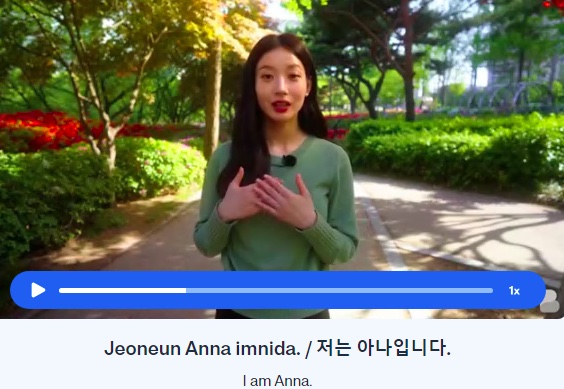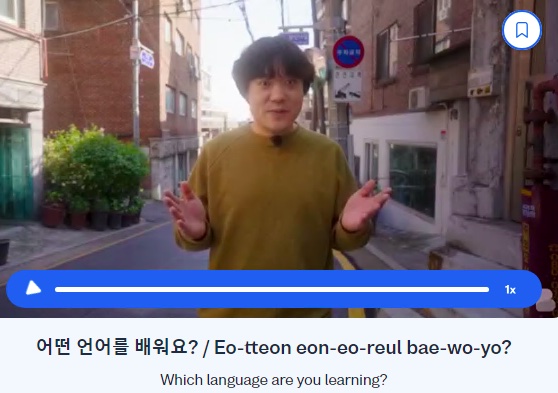How to Introduce Yourself in Korean
Let’s learn how to introduce yourself in Korean!
I want to learn...
If you’ve decided to start learning Korean, then learning how to introduce yourself in Korean should be the first step in your learning journey.
In many ways, the phrases we use to introduce ourselves are similar to other languages. However, there are also certain unique phrases we use in Korean, and when you introduce yourself in Korean, it’s important to use appropriate phrases to show the right level of formality and politeness to different people.
In this article, we will go through all these things and more so that the next time you meet a Korean person, you are ready to introduce yourself in Korean.
Formality
In Korea, first meetings are usually quite formal. We tend to use more formal and respectful language with people we are not familiar with, so a basic understanding of different speech levels is important.
In Korean, there are various speech levels, but in modern Korean, three speech levels are commonly used:
- Formal: This speech level is very formal and is used to express the highest level of respect and politeness. It is most commonly used in formal settings and more often used by the older generation.
- Polite: This speech level is not formal, but it still expresses politeness. It is the most commonly used speech level in everyday life, and it is used by people of all ages.
- Casual: This speech level is very casual, and it’s mainly used with close friends and close family members, typically with siblings. This speech level is not used when meeting people for the first time.
When we meet people for the first time, we can use both formal and polite speech levels. In more formal settings, or when we speak to people with a higher level of seniority, it’s more appropriate to use the formal form. In less formal settings, and when we speak to people of similar age or level, we can use the polite speech level.
In many situations, you can use either form, and whether you use one or the other depends on how formal and respectful you want to be. As we go through the key phrases used to introduce ourselves, we will show both the formal and polite forms.
But first, let’s discuss the correct body language to use in a basic Korean introduction.
Gestures
Bowing
Bowing is a big part of Korean greetings. As we say hello, it’s important to bow to be polite and respectful. If the other person is much older than you, then you should be prepared to bend your back about 45 to 60 degrees and bow. If the other person is of similar age, then you can just tilt your head down slightly and bow.
Handshakes
Handshakes are becoming more common in Korea. When we shake hands, if the other person is much older, then we should do a two-handed handshake. If not, then you can just use one hand. It’s also quite common to shake hands and bow at the same time, especially in more formal settings.
What to avoid
Excessive physical contact should be avoided at all times. Koreans don’t hug at first meeting, and kissing on the cheek is a definite no-no. Close friends might hug as they greet, but there is no hugging at the first meeting – you might unintentionally give the wrong impression.
Greetings
Now that you understand the right gestures to use, it’s time to learn the appropriate words and phrases you need when introducing yourself in Korean.
“Hello.”
안녕하세요. [An-nyeong-ha-se-yo.]
안녕하세요 is the formal and polite form of hello, and this is what we say when we meet people for the first time. As mentioned already, as you say 안녕하세요, you should bow to be respectful.
“It’s nice to meet you.” (1)
- Formal: 만나서 반갑습니다. [Man-na-seo ban-gap-seum-ni-da.]
- Polite: 만나서 반가워요. [Man-na-seo ban-ga-wo-yo.]
This phrase literally means “I’m pleased to see you,” so we use this phrase to say “It’s nice to meet you.”
“It’s nice to meet you.” (2)
처음 뵙겠습니다. [Cheo-eum boep-get-seum-ni-da]
This is another phrase we use as an “It’s nice to meet you.” This phrase literally translates to “I’m meeting you for the first time,” and it’s more often used in formal settings, so it’s only used in formal form.
“Please be kind to me.”
잘 부탁드립니다. [Jal bu-tak-deu-rim-ni-da]
It’s difficult to translate this phrase and the literal translation won’t make much sense either, but it kind of means, “I request you to be good.”
We often use this phrase at the end of our introductions. So after we have greeted the other person and have told them our name and other relevant details, we say this phrase to ask the person for their understanding and kindness. It’s a way of expressing our desire to form a good relationship with the other person.
This phrase is more commonly used when we join a new place, such as a workplace or school.
Giving your name
Let’s now take a look at how we can tell people our name and ask for theirs.
“I am Minsu Kim.”
- Formal: 저는 김민수입니다. [Jeo-neun Kim Minsu-im-ni-da.]
- Polite: 저는 김민수예요. [Jeo-neun Kim Minsu-ye-yo.]
The key structure is 저는… 입니다 (I am…), and we often use this phrase to introduce ourselves, but we can use this phrase in many other situations as well.
When Koreans introduce themselves, they tend to say their full name. So in the name 김민수, 김 is the family name, and 민수 is the first name. However, if you are a non-Korean, then you can just introduce yourself with your first name only.
“What’s your name?”
- Formal: 성함이 어떻게 되세요? [Seong-ham-i eo-tteo-ke doe-se-yo?]
- Polite: 이름이 뭐예요? [I-reum-i mwo-ye-yo?]
In Korean, there are two words for name: 성함 and 이름. 성함 is formal and 이름 is the standard word.
When you meet someone for the first time, if the other person is much older or has greater seniority, then you should use the formal phrase to ask their name. However, if you are in a less formal situation such as a birthday party, or if you are in your late teens or early twenties, then it’s more appropriate to ask “이름이 뭐예요?”
Both 어떻게 되세요 and 뭐예요 mean “What is (something)?”
Talking about age
Asking someone’s age at your first meeting may not be the norm in other cultures. However, in Korea, it is often one of the first things we ask when we meet people for the first time. This is because social hierarchy is based on age, so if we are not sure whether the other person is older or younger than us, then it’s important to find out so we can address them appropriately.
Having said that, if the other person is clearly 10 or 20 years older, then it’s not important to ask the other person’s age – in fact, asking the other person’s age may come across quite rude if they are much older than you.
“How old are you?”
- Formal: 나이가 어떻게 되세요? [Na-i-ga Eo-tteo-ke Dwe-se-yo?]
- Polite: 몇 살이에요? [Myeot sa-ri-e-yo?]
How we use these formal and polite expressions is the same as the way we ask someone’s name. 나이 is the standard word for age, and we use this word with 어떻게 되세요 to ask someone’s age in a formal and respectful way.
몇 means ‘how many,’ and 살 is the counter word for age. In less formal situations, we can say “몇 살이에요?” to ask someone’s age.
“I am 24 years old.”
- Formal: 저는 스물네 살입니다. [Jeo-neun seu-mul-ne sa-rim-ni-da.]
- Polite: 저는 스물네 살이에요. [Jeo-neun seu-mul-ne sa-rim-ni-da.]
The structure of these statements is the same as the sentences we use to say our name – 저는…. 입니다/이에요. When we say our age, we use the native Korean number to say our age. In the above phrases, 스물네 is the shortened form of 스물넷, which means 24.
Talking about where you’re from
In Korean, there isn’t one fixed way of telling people where we are from. We sometimes tell people our nationality to tell them where we are from, but we can also say where we have come from.
“I am an American.”
- Formal: 저는 미국 사람입니다. [Jeo-neun mi-guk sa-ram-im-ni-da.]
- Polite: 저는 미국 사람이에요. [Jeo-neun mi-guk sa-ram-i-e-yo.]
In these phrases, 사람 means ‘a person,’ and since 미국 means ‘USA,’ 미국 사람 means ‘an American person’ or ‘an American.’
In Korean, most country names are the same as in English, but we say the names phonetically in Korean. So Canada is 캐나다 [Kae-na-da], and Mexico is 멕시코 [Mek-si-ko]. However, some country names are completely different in Korean, as seen in the table below.
Country names in Korean
| USA | 미국 |
|---|---|
| UK | 영국 |
| China | 중국 |
| Japan | 일본 |
| Germany | 독일 |
| Australia | 호주 |
“I am from America.”
- Formal: 저는 미국에서 왔습니다. [Jeo-neun mi-gu-ge-seo wa-sseum-ni-da.]
- Polite: 저는 미국에서 왔어요. [Jeo-neun mi-gu-ge-seo wa-sseo-yo.]
In these phrases, 에서 means ‘from,’ and 왔습니다 or 왔어요 is the past form of 오다, which means ‘to come.’ Put together, these phrases literally mean “I came from the US.”
Talking about our jobs
Once the introductions are out of the way, the conversation may move on to talking about jobs.
“What do you do?”
- Formal: 무슨 일 하세요? [Mu-seun il-ha-se-yo?]
- Polite: 직업이 뭐예요? [Ji-geo-bi mwo-ye-yo?]
In the formal phrase, 무슨 means ‘what,’ 일 means ‘work,’ and 하세요 uses the verb 하다 meaning ‘to do,’ so this formal phrase literally means “What work do you do?”
In the polite phrase, 직업 means ‘job,’ and since 뭐예요 means ‘what is,’ 직업이 뭐예요 means “What is your job?”
“I am a teacher.”
- Formal: 저는 선생님입니다. [Jeo-neun seon-saeng-nim-im-ni-da.]
- Polite: 저는 선생님이에요. [Jeo-neun seon-saeng-nim-i-e-yo.]
We’ve already seen this sentence (저는… 입니다) before. In this example, the word 선생님 means ‘a teacher.’
Example sentences with different jobs
| English | Formal | Polite |
|---|---|---|
| I am a student. | 저는 학생입니다. | 저는 학생이에요. |
| I am an office worker. | 저는 회사원입니다. | 저는 회사원이에요. |
| I am a doctor. | 저는 의사입니다. | 저는 의사예요. |
| I am a nurse. | 저는 간호사입니다. | 저는 간호사예요. |
| I am a housewife/husband. | 저는 주부입니다. | 저는 주부예요. |
Conclusion
Introducing yourself is one of the first things you should learn in a foreign language, and it’s no different when it comes to Korean.
When you introduce yourself in Korean, you need to learn how to say hello and how to talk about things like your name, age and job. However, it’s important to keep in mind the appropriate level of formality to use for the situation and the person you are speaking with.
Now that you know how to introduce yourself in Korean, it’s important to practice what you have learned, and there is no better place to share your knowledge than with the millions of other language learners on the Busuu app.
Don’t stop now… continue learning more Korean!
This is just the beginning of your Korean learning journey! Go ahead and continue learning more Korean via Busuu’s free online courses and learning resources today.

